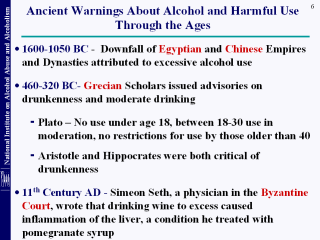| front |1 |2 |3 |4 |5 |6 |7 |8 |9 |10 |11 |12 |13 |14 |15 |16 |17 |18 |19 |20 |21 |22 |23 |24 |25 |26 |27 |28 |29 |30 |31 |32 |33 |34 |35 |36 |37 |38 |39 |40 |41 |42 |review |
 |
The ancients were familiar with
problems associated with excessive drinking and sought to protect
their societies from alcohol’s ill effects.
Excessive drinking was discouraged in ancient Greece, where
it was customary to drink diluted wine – three parts water to one
part wine. Drinking undiluted
wine, or becoming drunk were behaviors attributed to barbarians
(Nencini P. 1997, Subst Use Misuse, 32(1): 89-96).
In the Laws of Plato, the 5th century BC Greek philosopher
outlined appropriate behavior with regard to alcohol.
Drinking was forbidden for those under 18, as a “precaution
against the excitableness of youth.”
Moderate drinking was allowed between ages 18 and 30, with no
restrictions on drinking after age 40 (Plato, The Laws, Book II).
During the Middle Ages, physicians
began to describe specific pathologies resulting from excessive
alcohol consumption. Muhammad
Rhazes, a Persian physician of the 9th century AD, noted that
regular drunkenness could result in delirium, hemiplegia, sudden
death, and numerous other illnesses.
In the 11th century AD, Simeon Seth, a physician in
Constantinople, wrote that drinking wine to excess caused
inflammation of the liver (Sournia J.C. 1990, A History of
Alcoholism).
|